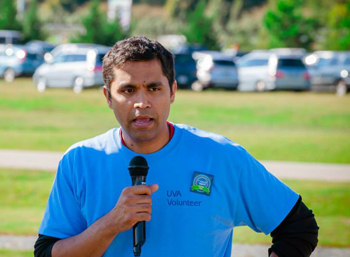You’ve probably never heard of it, and you may not be sure how to pronounce it. Yet neurofibromatosis (NF) affects millions worldwide, according to the Children’s Tumor Foundation. And given that May is Neurofibromatosis Awareness Month, we thought we’d introduce you.
Part of a group of genetic conditions that cause problems with the brain, spine, nervous system and/or skin, known as neurocutaneous disorders, NF affects the entire body. That’s why, at UVA, NF patients receive care from a multidisciplinary team of specialists.
NF Specialists: Q&A
We sat down with three doctors who specialize in neurofibromatosis, Radhika Dhamija, Benjamin Purow and Ashok Asthagiri, to get answers to some frequently asked questions.
Q: What is NF?

Dhamija: Neurofibromatosis is an inherited condition that predisposes individuals to tumor formation mostly along the nerves throughout the body.
Q: There are two main kinds of neurofibromatosis: NF1 and NF2. What’s the difference?
Dhamija: NF1 predominantly affects the nerves outside the brain and spinal cord, called peripheral nerves. NF2 tumors tend to arise in the central nervous system, specifically on the eighth cranial nerve, which affects hearing and balance.
Q: How does NF interfere with a patient’s quality of life?
Dhamija: NF1 is characterized by skin manifestations including café-au-lait macules or brown spots on the skin, freckling and benign peripheral nerve tumors that can occur anywhere in the body. These tumors can be painful and in some cases, with a kind of tumor called plexiform neurofibromas, can turn malignant.
Patients with NF1 also have other neurological problems like headaches and sleep difficulties. Children can have learning problems and attention issues. They are also at risk for gliomas (brain tumors).
NF2 leads to formation of tumors along the auditory nerve and so patients often have hearing loss and balance problems.
Q: How common is NF?
Dhamija: NF1 is one of the most common single gene disorders with a birth prevalence of about 1 in 3,500 worldwide.
NF2 is much less common, affecting 1 in 56,000.
Q: Why are you passionate about NF research and working with patients?
Purow: This is an understudied and underserved population. For such a common disease with such serious complications, there is not nearly enough research and clinical focus.
Get Neurofibromatosis Symptoms & Treatment Info:
Asthagiri: My passion for working with patients with NF comes from my desire to help patients who are typically receiving very fragmented and haphazard care. For me, as a neurosurgical oncologist, NF highlights the entire spectrum of tumors that can affect anyone (including those without NF), and developing better treatments for NF patients will not only help on an individual basis but will also lead the way for improvements in therapies for everyone.
Patients with NF have multiple problems, and it’s difficult to find a physician or clinic that is willing to put the effort to coordinate and balance these needs. This has been my goal since I started my professional practice, and I’m happy to have been able to bring that to UVA for NF patients as well.
Dhamija: I feel as a neurologist and as a geneticist, I understand these patients’ problems well and wear “two hats” for them, as this disorder is a bridge between neurology and genetics. This is an under-recognized disease, and we can certainly help these patients more by a multidisciplinary approach.
Q: How do you treat NF?
Purow: We treat NF through the recommended approaches, which include:
- Surgery to remove cancerous, painful or disfiguring tumors
- Medications and surgery to manage symptoms like seizures
- Radiation and chemotherapy for cancerous tumors
However, we’ll be creative when standard options aren’t available. We also take the latest research into account when possible.
Do you have NF1 or NF2? Find an NF doctor.
Asthagiri: We’re excited about the multidisciplinary care that we are providing patients with NF. We are also excited about the opportunities that we see in the near future which include participating in clinical trials that will help move treatment options further, faster.

My daughter has nf1 with plexiform neurofibroma, with intense itching and pain! She also has intestinal pain after every meal, occasionally vomiting. She has been losing weight. We’ve been coming to the pediatric GI clinic at UVA where they performed an endoscopy, and a gastric emptying test, both results were normal. She has had scans of her liver and surrounding structures several years ago, with normal outcomes. I cannot believe this isn’t NF related.
We’ve been going to the Duke NF clinic for several years but they have no new ideas for us. Can you give us hope?